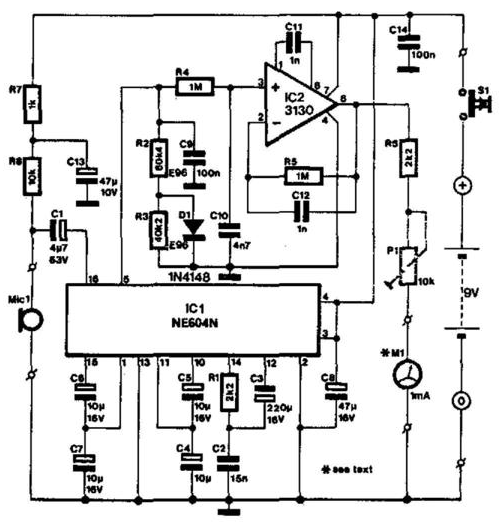The NE604`s signal-strength indicator section is used, based on an internal logarithmic converter. This enables a lineardecibel scale so that the moving-coil meter (shown in the diagram)
can be replaced by a digital instrument. The signal source is assumed to
be an electret microphone that converts ambient noise into an
electrical signal. Because this type of microphone normally contains a
buffer stage, R7, R8, and C13 have been included to provide the supply
voltage for this stage. The NE604 delivers an output current (at pin 5)
of 0 to 50, which causes a potential difference across R2 + R3 of 0 to 5
V.
Sound-Level Meter Circuit Diagram
The input and output signal range is equivalent to a sound range of
70 dB. lb compensate for the effects of temperature changes, the
required resistance of 100 KOhmhm is formed by two resistors (R2 and R3)
and a diode (Dl). Any ripple remaining on the output voltage is removed
by R4/C9/C10 before the output is buffered by IC2. The indicating
instrument, here a moving-coil meter, is connected to the output (pin 6)
of IC2 via a series resistance, R^ + .
The preset is adjusted to give
full-scale deflection (FSD) for an output voltage of 4 V. Calibrating
the meter is a little tricky, unless you have access to an already
calibrated instrument. Otherwise, if you know the efficiency of your
loudspeaker, that is, how many decibels for 1W at 1 m, you can use that
as reference. The scale of the meter can then be marked with the
(approximate) value. In any case, the meter deflection must at all times
be seen as an indication, not as an absolute value: it was not thought
to be worthwhile to add a filter to the circuit to enable absolute
measurements to be made.







0 comments:
Post a Comment